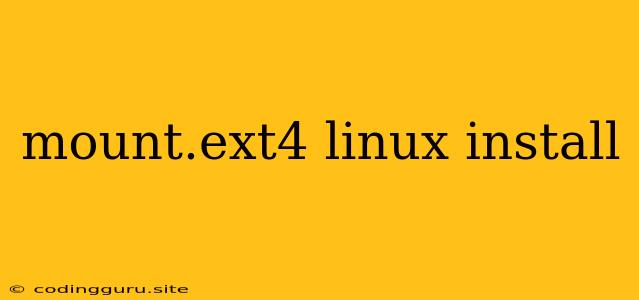Mount an Ext4 File System in Linux: A Comprehensive Guide
So you've got a Linux system and an ext4 formatted file system that you need to access, but it's not showing up in your file manager. This is where the mount command comes in! This article will guide you through the process of mounting an ext4 file system in Linux.
What is Ext4?
Ext4 is a file system commonly used in Linux distributions. It's an advanced version of the older ext3 file system, offering improved performance, scalability, and reliability.
Why do we need to mount an ext4 file system?
Think of a file system like a hard drive's directory structure. When you format a hard drive with ext4, it becomes accessible. However, when you have a separate storage device (like a USB drive, external hard drive, or a partition on your hard drive) formatted with ext4, it needs to be "mounted" before it can be accessed.
How to mount an ext4 file system in Linux:
1. Identify the Device
First, you need to know the device path of your ext4 file system. You can use the lsblk command to list all block devices connected to your system.
lsblk
Look for the device that has the ext4 file system. It might be something like /dev/sdb1, /dev/sdc, or /dev/sda2.
2. Create a Mount Point
Next, you need to create a directory where the file system will be mounted. This directory is known as a mount point. Choose a suitable location in your file system hierarchy.
sudo mkdir /mnt/ext4
3. Mount the File System
Now, you can use the mount command to attach the ext4 file system to your mount point.
sudo mount /dev/sdb1 /mnt/ext4
Replace /dev/sdb1 with the actual device path you found in step 1.
4. Verifying the Mount
You can verify that the ext4 file system is mounted successfully by navigating to the mount point using your file manager or by using the df command.
df -h
This will display a list of mounted file systems, and you should see your ext4 file system listed.
5. Automatic Mounting
If you want your ext4 file system to be mounted automatically on system startup, you need to add a line to your /etc/fstab file. This file contains information about file systems that should be mounted automatically.
Open the file using a text editor:
sudo nano /etc/fstab
Add a line with the following format:
/dev/sdb1 /mnt/ext4 ext4 defaults 0 2
Replace /dev/sdb1 and /mnt/ext4 with the correct device path and mount point.
Explanation of fields in /etc/fstab:
- First field: Device path (e.g.,
/dev/sdb1) - Second field: Mount point (e.g.,
/mnt/ext4) - Third field: File system type (e.g.,
ext4) - Fourth field: Mount options (e.g.,
defaults) - Fifth field: Dump frequency (usually
0) - Sixth field: File system check order (usually
2)
6. Unmounting the File System
When you're finished using the ext4 file system, you can unmount it using the umount command:
sudo umount /mnt/ext4
7. Troubleshooting Mounting Issues
If you encounter any issues while mounting your ext4 file system, here are a few things to check:
- Device path: Ensure you have the correct device path.
- Permissions: Make sure you have appropriate permissions to mount the device.
- File system type: Verify that the file system is indeed ext4.
- Mount point: The mount point directory must exist and have appropriate permissions.
/etc/fstab: Check for errors in your/etc/fstabfile.
Example:
Let's say you have an external hard drive connected to your Linux system that is formatted with ext4. The device path is /dev/sdb1.
-
Create a mount point:
sudo mkdir /mnt/external -
Mount the device:
sudo mount /dev/sdb1 /mnt/external -
Verify the mount:
df -h -
Add the mount to
/etc/fstab:sudo nano /etc/fstabAdd this line:
/dev/sdb1 /mnt/external ext4 defaults 0 2
Conclusion:
Now you have a comprehensive understanding of how to mount an ext4 file system in Linux. By using these steps, you can easily access your ext4 storage devices and manage their content within your Linux system. Remember to always unmount the file system before physically disconnecting the device to avoid data corruption.
